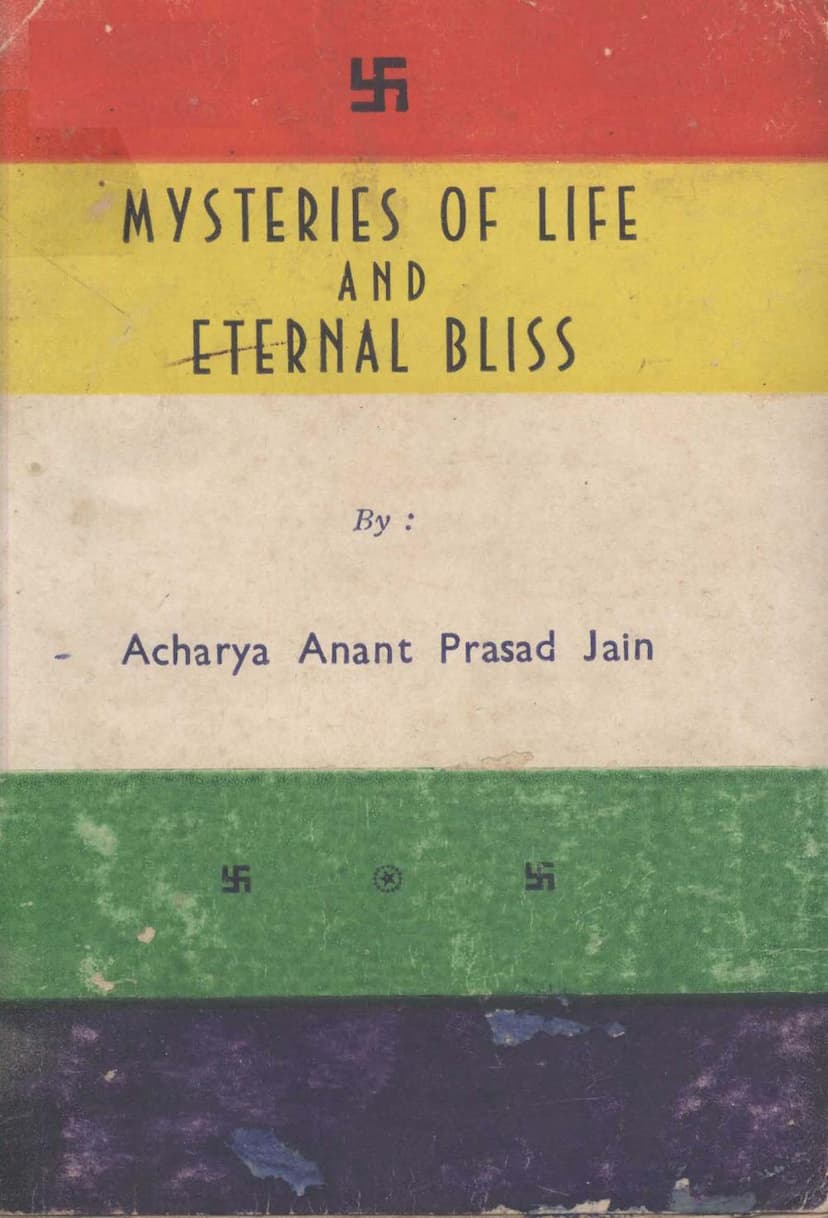Mysteries Of Life And Eternal Bliss
Added to library: September 2, 2025

Summary
This document is a summary of the Jain text "Mysteries of Life and Eternal Bliss" by Acharya Anant Prasad Jain. The book, published in 1979, aims to explain the fundamental principles of Jainism in a way that is accessible to a modern audience, bridging the gap between ancient religious thought and contemporary scientific understanding.
Here's a breakdown of the key themes and concepts presented in the book, based on the provided pages:
Core Philosophy and Concepts:
- Soul (Atma/Jiva) and Matter (Pudgala): The universe is composed of two fundamental realities: the Soul (conscious, pure, inherently divine) and Matter (unconscious, lifeless). All embodied beings are a combination of Soul and Matter.
- The Nature of the Soul: The Soul is eternal, indestructible, and possesses infinite potential. In its purest state, it is Omniscient and all-blissful, akin to God (Param-Atma). However, it becomes contaminated and limited by its association with matter.
- The Nature of Matter: Matter, at its most elementary level, consists of "Pudgalas," which the author equates to modern scientific concepts like electrons, protons, and neutrons. These particles combine to form atoms and molecules, which constitute everything in the material world. Matter is inert and has no consciousness of its own.
- Bondage and Liberation: The Soul's wandering in the cycle of birth and death (samsara) is due to its entanglement with matter. This entanglement is caused by Karma, which is essentially matter that attaches itself to the Soul due to passions and actions. Liberation (Moksha/Nirvan) is the state of freeing the Soul from all material bondage, leading to Eternal Bliss.
- Perpetual Change and Vibration: Everything in the universe, including Souls and matter, is in a state of constant vibration and change. This inherent dynamism is fundamental to existence and the cause of all phenomena.
- The Six Primary Substances (Dravyas): The book introduces the six fundamental substances of Jainism: Jiva (Soul), Pudgala (matter), Dharmadravya (medium of motion), Adharmadravya (medium of rest), Akash (space), and Kalanu (time unit). These are presented as the building blocks of reality.
Key Themes Explored in the Book:
- Science and Spirituality: The author, an engineer by profession, attempts to reconcile Jain philosophical concepts with scientific discoveries. He draws parallels between Jain principles and modern physics, chemistry, and biology, suggesting that ancient Jain insights often align with scientific findings.
- The Cause of Life and Consciousness: Life and consciousness are attributed solely to the presence of the Soul within a material body. Without the Soul, the body is merely lifeless matter.
- Karma and Heredity: The book explains Karma as a scientific process governed by molecular interactions. Heredity is viewed through the lens of molecular similarity between the Karmic body of a soul and the parents' genetic material. The book emphasizes that individuals are responsible for their own karmas and thus their destiny.
- The Path to Liberation (The Three Jewels): The ultimate goal of human life is to achieve liberation and Eternal Bliss. This is attainable through the practice of the "Three Jewels":
- Right Faith (Samyag Darshan): Believing in the true nature of the Soul and its potential for liberation.
- Right Knowledge (Samyak Gyan): Understanding the principles of Jain philosophy, the nature of reality, and the path to liberation.
- Right Conduct (Samyak Charitra): Living a life of ethical behavior, non-violence (Ahimsa), self-control, and detachment, guided by the teachings of the Tirthankaras.
- Samadhi (Self-Absorption/Meditation): The book highlights Samadhi as a crucial practice for achieving self-realization and liberation. It provides guidance on how to concentrate the mind and withdraw from worldly distractions to experience the true nature of the Soul.
- The Role of the Human Body: The human body is presented as a unique and valuable instrument for spiritual development. It is the "workshop" through which the Soul can shed impurities and progress towards liberation.
- Universal Oneness and Interdependence: The author emphasizes that everything in the universe is interconnected and interdependent. True happiness and peace can only be achieved through universal brotherhood and the upliftment of all.
- Critique of Misconceptions and Superstitions: The book challenges blind faith, mythology, and unfounded beliefs, advocating for a rational and scientific approach to spirituality. It also criticizes certain societal practices and prejudices, particularly regarding the status of women.
- The Importance of a Rational and Scientific Approach: The author consistently advocates for approaching religious and philosophical questions with an open mind, critical thinking, and a basis in wisdom and verifiable facts, rather than dogma or unsupported faith.
In essence, "Mysteries of Life and Eternal Bliss" seeks to demystify Jain teachings, presenting them as a logical, scientific, and practical path to understanding the fundamental truths of existence and achieving ultimate happiness and spiritual freedom. It encourages readers to explore their inner selves and strive for self-realization through disciplined living and rational inquiry.